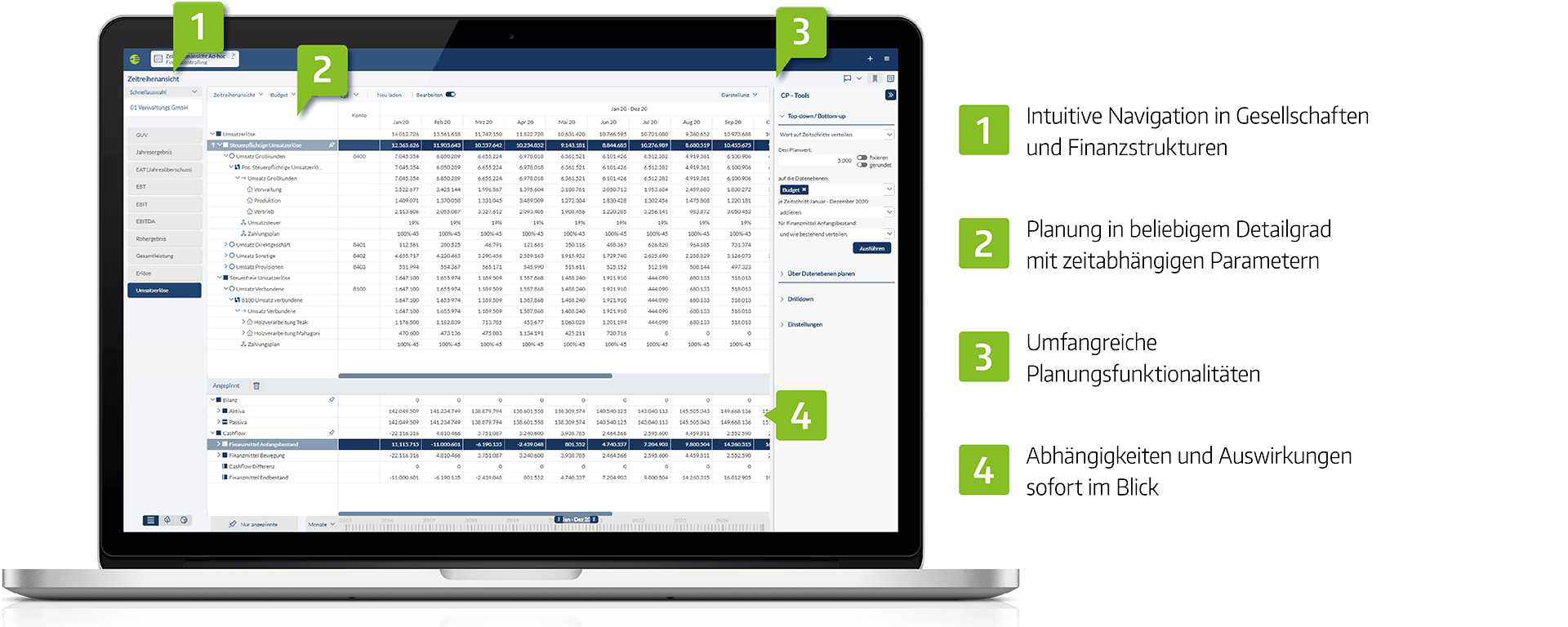Financial Management
detailed analyses, sound management

Complexity in financial planning is driven by a variety of factors, such as fluctuations in turnover, or investments and loans.
These challenges call for precision and flexibility to ensure your business is always solvent and profitable.
Corporate Planner provides an integrated platform that enables you to automate and optimize your company's financial planning. Easily merge your operational budgets and see straight away how they affect the P&L, cash flow and balance sheet. With live forecasting and scenario planning functions as well as automated data integration, our software gives you the transparency and efficiency you need for successful financial management.




Take an agile approach to your liquidity management. In our software, your P&L, balance sheet and cash flow statement are dynamically interlinked, so you can easily track the development of your company's liquidity over time and make sound decisions.
Plan your company's P&L at any level of detail in Corporate Planner. Our software provides you with all the functions you need, while also taking the business context into account – for more efficiency in your planning and analysis.
Plan the deployment of your financial resources and analyse how sustainable an investment has been. Our software provides you with the functions you need for managing fixed assets and loans, calculating depreciation and repayments, and planning best-case and worst-case scenarios.

Here you will find the product sheet in PDF format for Corporate Planning. You can view or download the data sheet directly on screen. Would you like to find out more about how you can exploit the full potential of financial controlling? Arrange a consultation or demonstration with one of our consultants.
This mid-sized company has improved its cash flow forecasts and has been making quicker, more confident investment decisions since implementing Corporate Planner.
What do the Corporate Planning software solutions deliver in practice? Nobody's better placed to tell us than the people working with them every day. Here's what some of our customers have to say.
The flexible, high-performance Corporate Planning software solution enables us to model all our processes and scenarios much more easily from start to finish. We were also impressed by the fact that no programming knowledge is required to create new reports.
The Corporate Planning software pools all our data sources and, thanks to its tree structure, provides a good overview. Navigation in the data sets is clear and simple, and KPIs for reporting can be set up quickly in a way that's easy to understand.
We've been using Corporate Planner for more than twenty years. The solution is ideal in that it enables us to visualize new and increasing demands again and again. We greatly appreciate this flexibility and the ongoing development of the Corporate Planning software.
The Corporate Planning software is easy to use and also visually appealing. The business logic in Corporate Planner Finance enables a rapid rollout, so the software can be used straight away.
Financial management is a central component of corporate performance management, which deals with the planning, control and monitoring of all the financial processes within a company. Its purpose is to safeguard the company's financial stability and profitability, as well as to provide reliable analyses and reports as a sound basis for decision-making.
Planning:
Control:
Monitoring:
Reporting:
Analysis:
Financial management is crucial for ensuring economic efficiency and helping companies to safeguard their long-term success. It delivers the transparency you need for managing financial risks and making your company fit for the future.
Budgeting:
Financial planning:
Liquidity management:
Cost accounting:
Investment appraisal:
Target-actual comparison:
Break-even analysis:
Variance analysis:
Risk and opportunity management:
Profitability ratios:
Liquidity ratios:
Debt ratios:
Turnover and cost ratios:
Value-based ratios:
Professional financial management software, such as Corporate Planner, offers companies considerable advantages by making financial processes more efficient and transparent. Software solutions such as these help finance departments to plan, analyse and report more efficiently and make better decisions based on the latest data. Here are some of the advantages that professional corporate performance management software – Corporate Planner in particular – has to offer in financial management:
1. Centralized, integrated data
2. Automation of processes
3. Flexible, dynamic planning
4. Transparency and traceability
5. Real-time data availability and reporting
6. Improved decision-making
7. Excellent usability and flexibility
8 Risk management and compliance
9. Scalability and integration with other systems
10 Collaboration and teamwork
The benefits of Corporate Planner – in a nutshell:
Take your company's financial management to the next level with Corporate Planner – improve efficiency and transparency over the long term.